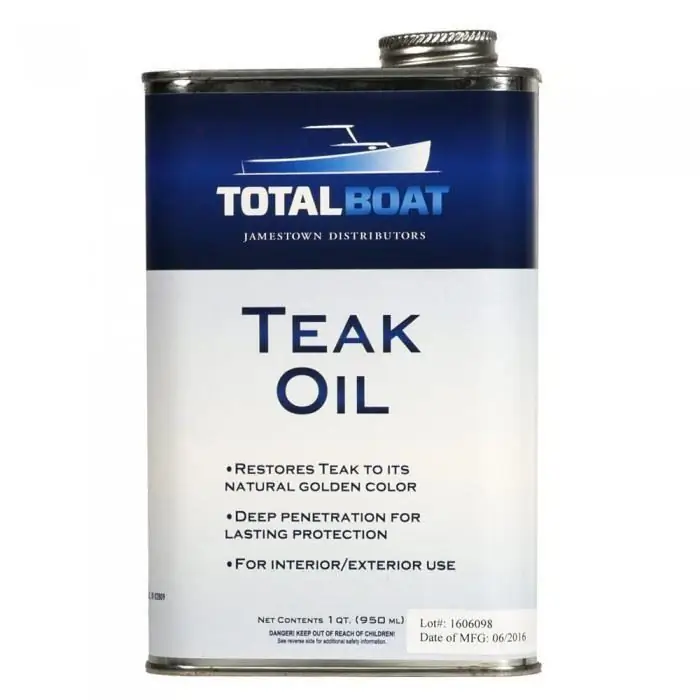It is known that teak is a valuable, even elite wood species. The unique characteristics of its wood, noble texture and age-old service life determine the use of this material in the creation of a wide variety of structures in construction, furniture production or shipbuilding. Many people mistakenly believe that wood has such properties due to a special substance that is part of its composition - teak oil. However, in fact, it has nothing to do with teak wood.
However, it is this composition that allows you to give ordinary wood the qualities inherent in the legendary tree. Fortunately, today it is not at all difficult to purchase this oil: a similar product is quite common on the shelves of construction and hardware stores. It is it that is used to improve the technical and operational qualities of any wooden products.
Teak oil contains at least three plant ingredients and synthetic additives. Usually as the main raw material for its manufacturethey use vegetable oils of flax, soybean and tung tree seeds, and synthetic substances are added as regulators and improvers.

Properties of teak oil
The main advantages of this product include a special ability to give wooden products a gloss and a deep radiant shade. Do not forget that with its help technical indicators are improved - the service life of wooden products is significantly increased. In addition, the treatment of wood with teak oil helps to impregnate the surface and middle layers, so that the material does not dry out and does not crack. The use of such impregnations provides reliable resistance to the harmful effects of water and the sun - treated wood is not afraid of any vagaries of nature. Therefore, a similar composition is used to care for products that are not only indoors, but also outdoors for processing terraces, sun loungers, benches, railings, entrance doors or window frames.
The indisputable advantages of this product include ease of use. It is thanks to this that this processing substance remains popular and in demand.

Flaws
The most significant disadvantages of teak oil (consumer reviews testify to this) is that it is necessary to choose dry, warm days for processing elements of buildings and outdoor wooden decor. If processing is carried out indoors, then it is necessary to create good circulation of fresh air.

Processing methods
Usually store-bought impregnation mixes are ready to use. Sometimes, in order to create a more liquid consistency, they are diluted with purified turpentine. Depending on the type of wood being processed, there are two ways to process it.
If it is planned to process a new product, as well as a product that has never been treated with teak oil or other types of impregnation before, then its surface is supposed to be preliminarily prepared. To do this, it is cleaned, dried thoroughly and sanded along the fibers with fine or medium abrasive paper. Dust generated during the grinding process must be completely removed. Only after that, an oil layer is applied along the wood fibers using a special dispenser or a high-quality paint brush. The repeated use of teak oil makes it possible to eliminate the surface grinding process, since the wood no longer needs it. In this case, a fresh layer of oil impregnation is applied to its cleaned and dried surface.

Subtleties of work
When applying oil, remember that it is applied in a generous layer and rubbed thoroughly. First of all, the ends and edges of the wooden product are processed. It is in these places, due to the capillary effect of the fibers, that the treatment composition is intensively absorbed.
After 15-20 minutes, excess impregnation is removed with a towel or rag. This will excludethe formation of puddles and spots on the surface of the products and will allow the oil layer to be absorbed evenly.

How many coats of impregnation is required?
The oil dries completely within six hours, so further processing of the product is carried out only after this time has elapsed. It is believed that at least three stages of impregnation are necessary to achieve optimal wood characteristics. Many craftsmen recommend this process until the oil is no longer completely absorbed into the wood.
Finishing touch
At the end of teak oil treatment, the surface of the product is treated with cloth. This is what gives the tree deep sparkling shades, transparency and gloss. However, often, even after careful processing and prolonged drying, the wooden surface remains sticky and continues to absorb moisture. Therefore, as the final stage of wood processing, the surface is covered with oils that harden after drying. Due to the ability to hermetically clog the pores of wood, they contribute to a long service life of the product. In addition, they also give the product an excellent shine.

What can replace teak oil?
For the primary finishing of wooden coatings, oils are used that do not harden after drying. Linseed and tung oil are excellent alternatives to teak oil. They are obtained from the seeds of these plants. Although both of these products are curable oils, they are notvery good for finishing. For their complete polymerization, a rather long time is required, much longer than for absorption and drying on a wooden surface. It will take at least two weeks for raw linseed oil to harden. Pure tung oil takes about three days to polymerize. Therefore, if it is necessary to speed up the hardening process, special metal-containing desiccants are added to these oils, but then the oil compositions acquire completely different properties and are called quite differently.






